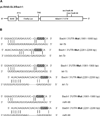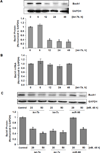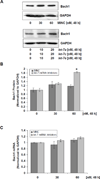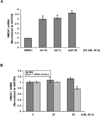The let-7 microRNA enhances heme oxygenase-1 by suppressing Bach1 and attenuates oxidant injury in human hepatocytes
- PMID: 22698995
- PMCID: PMC3480558
- DOI: 10.1016/j.bbagrm.2012.06.001
The let-7 microRNA enhances heme oxygenase-1 by suppressing Bach1 and attenuates oxidant injury in human hepatocytes
Abstract
The let-7 microRNA (miRNA) plays important roles in human liver development and diseases such as hepatocellular carcinoma, liver fibrosis and hepatitis wherein oxidative stress accelerates the progression of these diseases. To date, the role of the let-7 miRNA family in modulation of heme oxygenase 1 (HMOX1), a key cytoprotective enzyme, remains unknown. Our aims were to determine whether let-7 miRNA directly regulates Bach1, a transcriptional repressor of the HMOX1 gene, and whether indirect up-regulation of HMOX1 by let-7 miRNA attenuates oxidant injury in human hepatocytes. The effects of let-7 miRNA on Bach1 and HMOX1 gene expression in Huh-7 and HepG2 cells were determined by real-time qRT-PCR, Western blot, and luciferase reporter assays. Dual luciferase reporter assays revealed that let-7b, let-7c, or miR-98 significantly decreased Bach1 3'-untranslated region (3'-UTR)-dependent luciferase activity but not mutant Bach1 3'-UTR-dependent luciferase activity, whereas mutant let-7 miRNA containing base complementarity with mutant Bach1 3'-UTR restored its effect on mutant reporter activity. let-7b, let-7c, or miR-98 down-regulated Bach1 protein levels by 50-70%, and subsequently up-regulated HMOX1 gene expression by 3-4 fold, compared with non-specific controls. Furthermore, Huh-7 cells transfected with let-7b, let-7c or miR-98 mimic showed increased resistance against oxidant injury induced by tert-butyl-hydroperoxide (tBuOOH), whereas the protection was abrogated by over-expression of Bach1. In conclusion, let-7 miRNA directly acts on the 3'-UTR of Bach1 and negatively regulates expression of this protein, and thereby up-regulates HMOX1 gene expression. Over-expression of the let-7 miRNA family members may represent a novel approach to protecting human hepatocytes from oxidant injury.
Copyright © 2012 Elsevier B.V. All rights reserved.
Figures









Similar articles
-
MicroRNA-196 represses Bach1 protein and hepatitis C virus gene expression in human hepatoma cells expressing hepatitis C viral proteins.Hepatology. 2010 May;51(5):1494-504. doi: 10.1002/hep.23401. Hepatology. 2010. PMID: 20127796 Free PMC article.
-
Reciprocal effects of micro-RNA-122 on expression of heme oxygenase-1 and hepatitis C virus genes in human hepatocytes.Gastroenterology. 2007 Oct;133(4):1166-74. doi: 10.1053/j.gastro.2007.08.002. Epub 2007 Aug 3. Gastroenterology. 2007. PMID: 17919492 Free PMC article.
-
MicroRNA-let-7c suppresses hepatitis C virus replication by targeting Bach1 for induction of haem oxygenase-1 expression.J Viral Hepat. 2019 Jun;26(6):655-665. doi: 10.1111/jvh.13072. Epub 2019 Mar 13. J Viral Hepat. 2019. PMID: 30706605
-
New biotechnological methods to reduce oxidative stress in the cardiovascular system: focusing on the Bach1/heme oxygenase-1 pathway.Curr Pharm Biotechnol. 2006 Apr;7(2):87-93. doi: 10.2174/138920106776597630. Curr Pharm Biotechnol. 2006. PMID: 16724942 Review.
-
BACH1, the master regulator gene: A novel candidate target for cancer therapy.Gene. 2016 Aug 15;588(1):30-7. doi: 10.1016/j.gene.2016.04.040. Epub 2016 Apr 22. Gene. 2016. PMID: 27108804 Review.
Cited by
-
Identification of circulating microRNAs during the liver neoplastic process in a murine model of hereditary tyrosinemia type 1.Sci Rep. 2016 Jun 10;6:27464. doi: 10.1038/srep27464. Sci Rep. 2016. PMID: 27282650 Free PMC article.
-
MicroRNA-98: the multifaceted regulator in human cancer progression and therapy.Cancer Cell Int. 2024 Jun 13;24(1):209. doi: 10.1186/s12935-024-03386-2. Cancer Cell Int. 2024. PMID: 38872210 Free PMC article. Review.
-
Redox signaling and skeletal muscle adaptation during aerobic exercise.iScience. 2024 Mar 29;27(5):109643. doi: 10.1016/j.isci.2024.109643. eCollection 2024 May 17. iScience. 2024. PMID: 38650987 Free PMC article. Review.
-
mirDIP 4.1-integrative database of human microRNA target predictions.Nucleic Acids Res. 2018 Jan 4;46(D1):D360-D370. doi: 10.1093/nar/gkx1144. Nucleic Acids Res. 2018. PMID: 29194489 Free PMC article.
-
The role of microRNAs in the pathogenesis, grading and treatment of hepatic fibrosis in schistosomiasis.Parasit Vectors. 2019 Dec 30;12(1):611. doi: 10.1186/s13071-019-3866-0. Parasit Vectors. 2019. PMID: 31888743 Free PMC article. Review.
References
-
- Elbirt KK, Bonkovsky HL. Heme oxygenase: recent advances in understanding its regulation and role. Proc Assoc Am Physicians. 1999;111:438–447. - PubMed
-
- Bonkovsky HL, Elbirt KK. Heme Oxygenase: Its Regulation and Role. In: Cutler RG, Rodriguez H, editors. Oxidative Stress and Aging, World Scientific. River Edge, NJ: 2002. pp. 699–706.
-
- Brugger J, Schick MA, Brock RW, Baumann A, Muellenbach RM, Roewer N, Wunder C. Carbon monoxide has antioxidative properties in the liver involving p38 MAP kinase pathway in a murine model of systemic inflammation. Microcirculation. 2010;17:504–513. - PubMed
-
- Wu TW, Carey D, Wu J, Sugiyama H. The cytoprotective effects of bilirubin and biliverdin on rat hepatocytes and human erythrocytes and the impact of albumin. Biochemistry and cell biology. 1991;69:828–834. - PubMed
Publication types
MeSH terms
Substances
Grants and funding
LinkOut - more resources
Full Text Sources
Other Literature Sources
Research Materials
Miscellaneous

